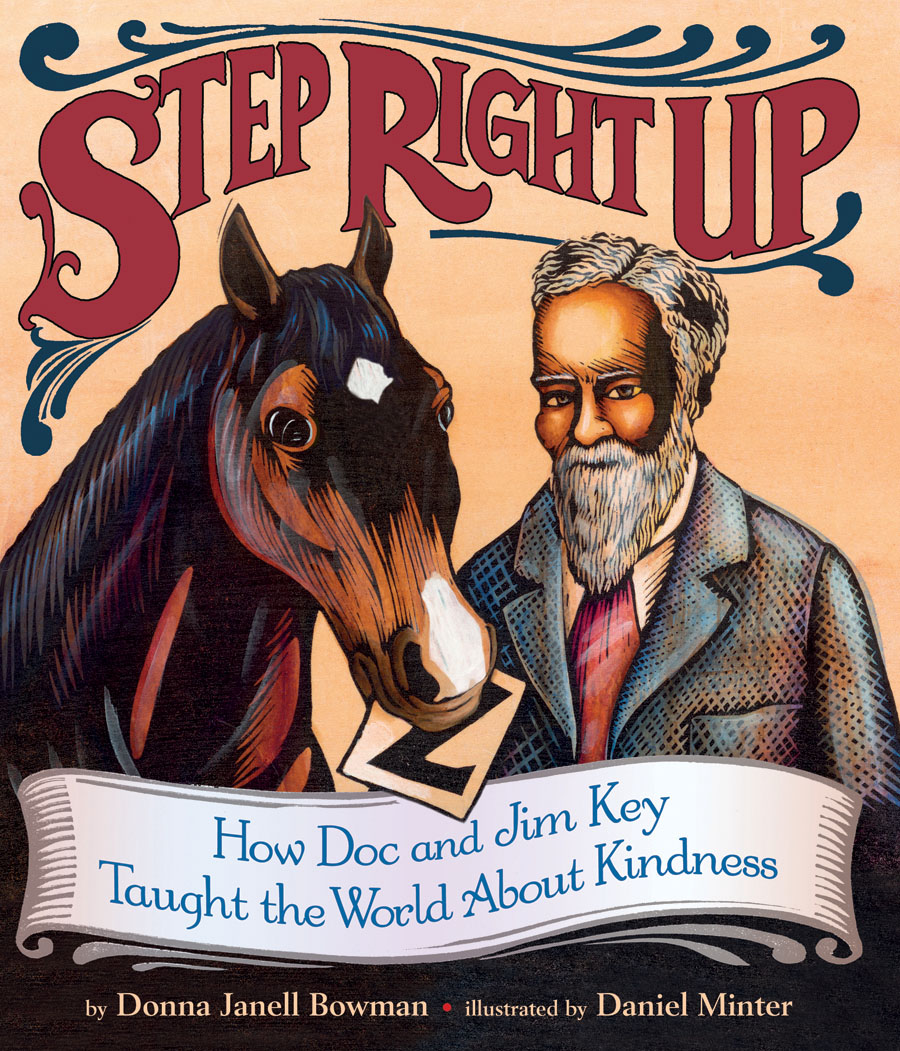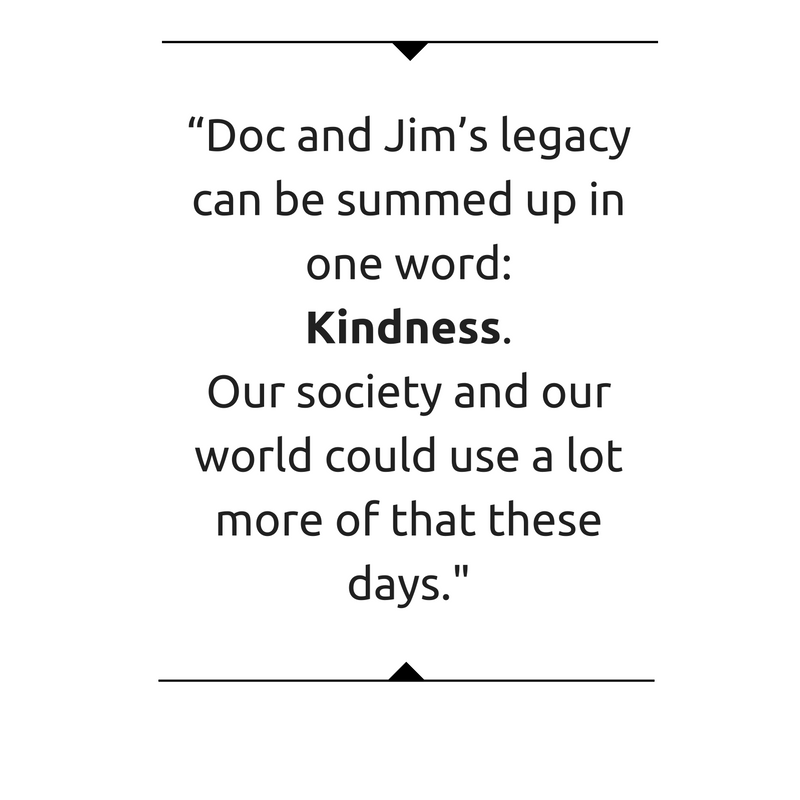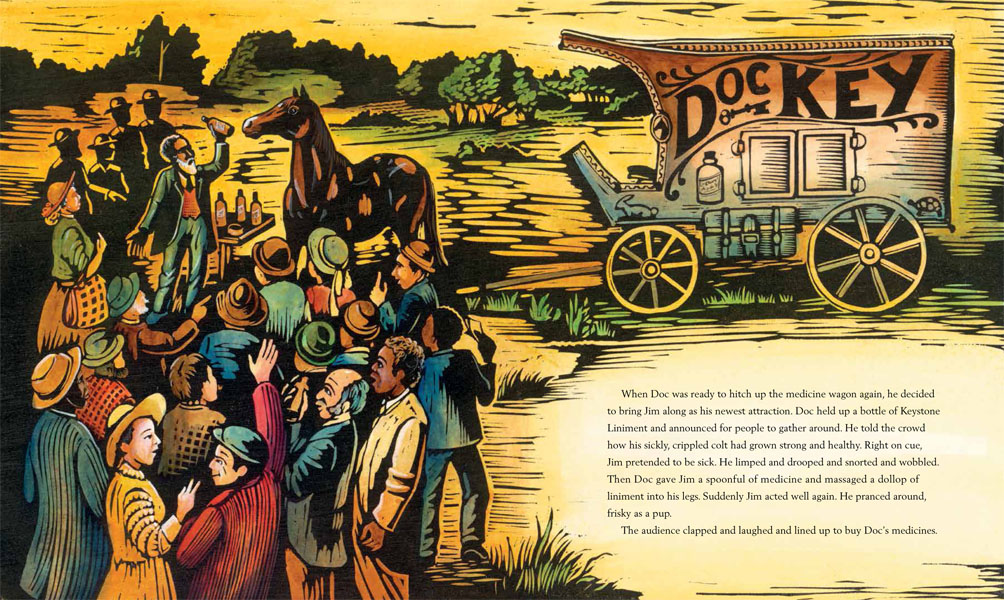 Step Right Up: How Doc and Jim Key Taught the World About Kindness is a biography of William “Doc” Key, a formerly enslaved man and self-trained veterinarian who taught his horse, Jim, to read, write, and do math. Together they became a famous traveling performance act and proponents for the humane treatment of animals around the turn of the twentieth century. In this interview, author Donna Janell Bowman discusses the power of Doc and Jim Key’s message of kindness and what inspired her to write about one of the most famous performing duos in the country.
Step Right Up: How Doc and Jim Key Taught the World About Kindness is a biography of William “Doc” Key, a formerly enslaved man and self-trained veterinarian who taught his horse, Jim, to read, write, and do math. Together they became a famous traveling performance act and proponents for the humane treatment of animals around the turn of the twentieth century. In this interview, author Donna Janell Bowman discusses the power of Doc and Jim Key’s message of kindness and what inspired her to write about one of the most famous performing duos in the country.
Many of us have never heard of William “Doc” Key and Jim Key. How did you find out about a horse that can read, write, and do math? Did you believe this was true?
In 2006, I picked up a new book written for adults, Beautiful Jim Key: The Lost History of a Horse and a Man Who Changed the World, by Mim Eichler Rivas. Having a strong background with horses, I was naturally curious. I was also very skeptical. Though I know how incredible the human-animal bond can be, the idea of teaching a horse to read, write, spell, calculate, etc, seemed far-fetched. I had to do my own research. In so doing, I found Doc’s explanations about how he taught Jim some of his most impressive skills. Those skills not explained by Doc, or not documented in print, will probably remain a glorious mystery.
What inspired you to write about Doc and Jim Key?
I believe there is a piece of me in everything I write, so it’s probably not surprising that I would be drawn to a story featuring a remarkable horse. As one who also tends to root for the underdog and celebrate those who blast through obstacles, I found William “Doc” Key’s story equally remarkable and inspiring. Ultimately, though Beautiful Jim Key became famous for his onstage feats of “education,” the real significance of the story is how Doc and Jim helped fuel the humane movement, and how they changed people’s minds about the way animals should be treated. In the process, perhaps they changed the way people treated each other, too. Doc and Jim’s legacy can be summed up in one word: Kindness. Our society and our world could use a lot more of that these days.
Tell us about your research process. What challenges, if any, did you face when researching? Did you find it difficult to tighten the narrative and focus on certain elements?
I love research, so one challenge was knowing when to stop digging and start working on a narrative. In fact, I never really did stop researching, even after the books were off to the printer—that’s how invested I am in the story. Riva’s adult book was my launch point and I relied on it to fill in gaps when I hit the occasional wall.
Doc did not keep a journal or diary. And he was widowed three times and left no children, so there was nobody to carry forth his full story. Thankfully, an indirect descendent of his last wife, in possession of original materials, wrote a book about Doc in the 1970’s, so that was a big help. As were promotional booklets about Doc and Jim, published between 1898-1906, and countless newspaper articles, many with witness accounts and interviews with Doc.
To fully understand the time and place, I also read extensively about slavery and Civil War experiences in Tennessee. In 2009, I dragged my husband and youngest son to Shelbyville, where Doc and Jim lived. We visited the humble memorial to Beautiful Jim Key, then paid respects at Doc’s grave at the Willow Mount Cemetery. I hunkered down at the Shelbyville Public Library and squinted through microfilm for articles about Doc and Jim. Then, I spent some time at the Tennessee State Archives in Nashville, donning white gloves to peruse crumbling scrapbooks.
Is there a fact about Doc and Jim Key that you didn’t get to put in the book?
Oh my goodness, there were so many facts that didn’t fit in the book! Like how, during Doc and Jim’s performance years, people were astonished by Jim’s regular feat of sticking his head into a bucket of water to retrieve a silver dollar, without drinking a drop. Horses don’t like to get their heads wet. And how Doc festooned a garland of five thousand rabbit’s feet—said to have been collected from Civil War Battlefields—over Jim’s stall because he believed they calmed Jim and brought luck. This could probably be traced to hand-me-down cultural superstitions. And how Jim spelled Alice Roosevelt’s name and pulled the right numbered card when her age was whispered into his ear.
In Step Right Up, the story did not shy away from the realities of racism and the numerous obstacles that Doc Key faced as a formerly enslaved man. Despite these obstacles, Doc Key became a self-taught veterinarian and, together with Jim Key, one of the most famous performing duos in the country. What can readers learn from Doc Key’s resilience and persistence?
I hope readers will resonate with the story in individual ways: by the indomitable human spirit that resides in all of us; with Doc’s fundamental goodness and willingness to take a stand; with his example of diplomatic and peaceful co-existence with all people; with his conviction and never-give-up attitude; with his empathy and compassion. And, of course, I hope readers keep that one simple word in mind: kindness.
One of our favorite themes in Step Right Up is the importance and power of kindness toward people and animals alike. Tell us how you were able to incorporate this message into your story.
Incorporating the theme into the story was a matter of focusing on Doc’s actions, his relationship with Jim, how people responded, and how humane societies flourished, thanks to proceeds from Doc and Jim’s performances. Doc and Jim’s example truly caused a ripple effect.
The final spread of the book includes this quote from an 1898 Atlanta Constitution article that sums it up: “It is hoped that those who have met Jim Key will have carried away with them a kinder regard toward animals and will go forth resolved to whatever may be in their power for the care of our . . . friends.” To expand on that, I hope readers imbibe a sense of hope, persistence, compassion, and respect for each other, and all who inhabit planet Earth.
Learn more about Step Right Up: How Doc and Jim Key Taught the World About Kindness here.
You can find our Teacher’s Guide for Step Right Up: How Doc and Jim Key Taught the World About Kindness here.
 Donna Janell Bowman grew up on a quarter horse ranch where she trained for horse shows and developed her passion for writing. When she first heard about Doc and Jim Key, Bowman was skeptical about Jim’s “education.” But after doing her own research, she was inspired to share Doc and Jim’s fascinating story with young readers. Bowman lives in Texas with her family and their rescue animals. This is her debut book.
Donna Janell Bowman grew up on a quarter horse ranch where she trained for horse shows and developed her passion for writing. When she first heard about Doc and Jim Key, Bowman was skeptical about Jim’s “education.” But after doing her own research, she was inspired to share Doc and Jim’s fascinating story with young readers. Bowman lives in Texas with her family and their rescue animals. This is her debut book.



I have read the book on the Amazing William “Doc” and Jim Key. It is wonderfully written and illustrated. Thank you for all your hard work.